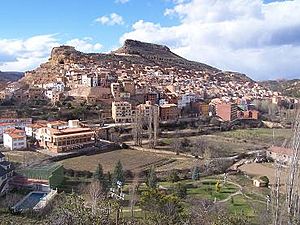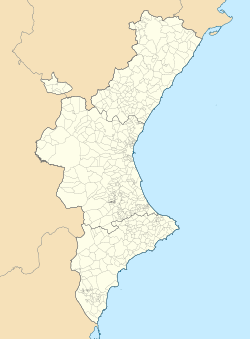Ademuz facts for kids
Quick facts for kids
Ademuz
|
||
|---|---|---|
| Ademuz | ||

Panoramic view
|
||
|
||
| Country | ||
| Autonomous community | ||
| Province | Valencia | |
| Comarca | Rincón de Ademuz (Racó d'Ademús) | |
| Judicial district | Liria | |
| Area | ||
| • Total | 100.42 km2 (38.77 sq mi) | |
| Elevation | 660 m (2,170 ft) | |
| Population
(2018)
|
||
| • Total | 1,046 | |
| • Density | 10.416/km2 (26.978/sq mi) | |
| Demonym(s) | Ademucero/-a | |
| Time zone | UTC+1 (CET) | |
| • Summer (DST) | UTC+2 (CEST) | |
| Postal code |
46140
|
|
| Official language(s) | Spanish | |
Ademuz is a small town, also called a municipality, in Spain. It is located in a special area called the Rincón de Ademuz, which is part of the Valencian Community. Even though it's in the Valencian Community, people in Ademuz mostly speak Spanish, not Valencian.
Contents
History
Ancient Times and Early Records
People have lived in the Ademuz area for a very long time! We know this because archaeologists have found old things from different periods, like the Stone Age (Neolithic), Iberian, and Roman times.
The first written records about Ademuz come from Arabic writings. These old texts talk about its important castle. The castle was built in a great spot, high up, which allowed it to control the Turia River and the main path from Aragon to the city of Valencia.
Conquest and Royal Control
The Muslim fortress of Al-Dāmūs was taken over by Peter II of Aragon in 1210. He got help from knights from the Hospitalier and Templar orders. As a reward, these knights were allowed to collect some taxes from the area.
However, the castle soon fell back into Muslim hands. Later, James I of Aragon finally added Ademuz to the Kingdom of Valencia. He made sure it was directly controlled by the king, just like another important village in the area called Castielfabib.
Life as a Royal Town
Since it was a "royal villa," Ademuz got to send a person they chose to represent them at the Corts Valencianes, which was like a parliament.
Ademuz was also a border fortress, meaning it was on the edge of the kingdom. This made it suffer during wars with Castile in the 1300s. Both Ademuz and Castielfabib were invaded and taken over by Peter I of Castile.
The people of Ademuz were very brave and loyal in defending their town. Because of their courage, Peter IV of Aragón and the kings after him gave Ademuz new rights and special benefits.
Later Challenges
From the early 1300s, Ademuz and its countryside were also linked to the Order of Montesa, a group of knights. However, this order didn't actually rule Ademuz. They just had the right to collect some taxes.
On June 7, 1656, a huge earthquake hit Ademuz. It destroyed the old church, the town hall, and many houses. The walls and towers of the castle were also ruined. Even so, Ademuz's castle was still useful during the many civil wars in the 1800s. It was taken over and rebuilt several times by soldiers called carlist troops.
Over time, the two main towns in the Rincón de Ademuz, Castielfabib and Ademuz, started to split up. Several smaller villages that grew in size and importance, like Vallanca, Puebla de San Miguel, Casas Altas, and Casas Bajas, became their own separate municipalities.
Geography
Ademuz is located in the middle of the Rincón de Ademuz. This area is a special part of Spain because it's an "exclave." This means it's a piece of the Valencian Community that is surrounded by other provinces, specifically Cuenca (in Castile-La Mancha) and Teruel (in Aragon).
The town of Ademuz also includes three smaller villages, called pedanías: Mas del Olmo, Segsa, and Val de la Sabina.
Demography
According to the 2008 census, Ademuz had a population of 1,269 people. The timeline below shows how the population has changed over the years.

Gallery
Literature
If you want to learn more about Ademuz, here are some books you could check out:
- Candel Tortajada, F.: Viaje al Rincón de Ademuz. Barcelona, 1977. ISBN: 84-01-44182-X
- Eslava Blasco, R.: Ademuz y su patrimonio histórico-artístico. Ademuz, 2007. ISBN: 978-84-606-4251-0
See also
 In Spanish: Ademuz para niños
In Spanish: Ademuz para niños







